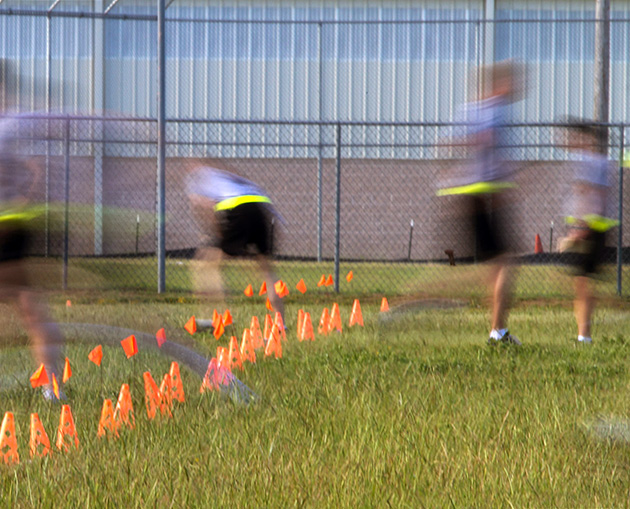30-15 Intermittent Fitness Test (30-15 IFT) is an intermittent fitness test created by Martin Buchheit (2008), to more closely replicate the demands of intermittent sports compared to the standard beep test. Unlike in the beep test, where athletes run continuously with increasing speed every minute, this test involves 30 seconds of running alternated with 15 seconds of walking over a 40m course. There is a similar test, the Interval Shuttle Run Test (ISRT) with the same work/rest intervals but with different running speeds and over a 20m course. The Yo-Yo intermittent tests is another intermittent type beep test.
test purpose: To assess the ability to recover and repeat intermittent activity, similar to many sporting situations.
equipment required: clear flat area for conducting the test at least 40m long, audio recording of test, marker cones.
pre-test: Explain the test procedures to the subject. Perform screening of health risks and obtain informed consent. Prepare forms and record basic information such as age, height, body weight, gender, test conditions. Measure and mark out the course. Ensure that the participants are adequately warmed-up. See more details of pre-test procedures.
test layout: Mark out a 40m area with markers at either end and at the midpoint (20m). Also place markers 3 meters before each end line and either side of the mid-line (tolerance zones).
 running a shuttle test
running a shuttle testprocedure: The test involves 30 seconds of running alternated with 15 seconds of walking. Participants start behind one of the end lines, spaced from each other by one meter minimum. They begin to run on the first "beep", pacing their effort to be in the area around the midline at the second "beep", then arrive at the opposite end at the third "beep". This continues until there is a double beep, indicating the end of the 30 second period, and which point they stop running. This will not necessarily be at either end line. They then walk forwards to the next line, waiting for the start of the next level in 15 seconds. As listed in Buchheit (2008), the initial velocity is 8.0 km/hr, with increments increased by 0.5 km/hr every 45-second stage thereafter. The test ends when the athlete does not make it into the tolerance zone three times. See 30-15 test video examples.
scoring: The speed of the final phase completed in full is taken as the score (VIFT). Use the following formula to estimate VO2max based on the final running speed, where VIFT is the final running speed, G stands for gender (female = 2; male = 1), A for age, and W for weight (Buchheit, 2008).
VO2max (ml.kg-1.min-1) = 28.3 – (2.15 x G) – (0.741 x A) – (0.0357 x W) + (0.0586 x A x VIFT) + (1.03 x VIFT)
target population: This test was developed for team sport players, players of sports which are intermittent in nature.
advantages: this test is more relevant to intermittent sports rather than the commonly used beep test.
disadvantages: the test is not commonly used so normative values are hard to find. Also the audio recording is difficult to create and not readily available to purchase.
variations:
- There are versions of this test to suit different sports: there is one for ice hockey players (Buchheit et al., 2011) with modified speeds to account for different speed of skating, and a basketball version (Haydar & Buchheit, 2009) modified to be conducted indoors on a 28m long basketball court.
- Similar tests are the Interval Shuttle Run Test (ISRT), with periods of 30 secs running and 15 walking though shuttling over a 20m course, and the yo-yo intermittent tests.
references:
- Buchheit M. The 30-15 Intermittent Fitness Test: accuracy for individualizing interval training of young intermittent sport players. Journal of Strength and Conditioning Research: 22: 365-374, 2008.
- Buchheit M, Al Haddad H, Millet GP, Lepretre PM, Newton M, Ahmaidi S. Cardiorespiratory and cardiac autonomic responses to 30-15 intermittent fitness test in team sport players. J Strength Cond Res 2009; 23(1):93-100.
- Haydar B. & Buchheit M. Le 30–15 Intermittent Fitness Test : Application pour le Basketball. Pivot, 143, 2-5, 2009.
- Buchheit M. The 30–15 Intermittent Fitness Test: a 10-year review. Myorobie Journal, 1, 1-9, 2010.
- Buchheit M, Lefebvre B, Laursen PB, Ahmaidi S. Reliability, usefulness, and validity of the 30–15 Intermittent Ice Test in young elite ice hockey players. J Strength Cond Res. 2011; 25(5): 1457–1464
Similar Tests
- Interval Shuttle Run Test (ISRT) — an intermittent fitness test where athletes run for 30 seconds periods interspersed with 15 seconds of walking.
- Yo-Yo Intermittent Tests — aerobic shuttle test, with a short active break (5 and 10 seconds ) after every 2 x 20m shuttle.
- Gacon Test — an intermittent test with 45 seconds of running and 15 seconds rest, with the running distance incrementally increasing.
- Loughborough Intermittent Shuttle Test — intermittent and variable shuttle test designed to replicate the demands of a football/soccer match.
Related Pages
- A script to conduct the 30-15 test is included in the latest version of the Team BeepTest Software, though because of software limitations the timings are a little different to the original test.
- Video examples of the 30-15 Intermittent Fitness Test
- About Testing for Intermittent Sports


 Current Events
Current Events